Dandelion
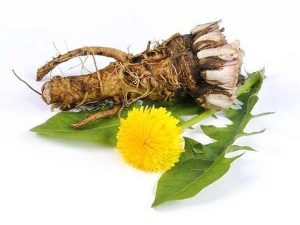
Dandelion (Taraxacum officinale) is a perennial plant in the Asteraceae family. It is considered a unique plant that is distributed almost throughout the globe, but most of all - in temperate climates.
Dandelion has the following names in other languages:
- German - Butterblume, Kuhblume, Pusteblume, Wilde Zichorie;
- in English - dandelions;
- in French – dent de lion, pissenlit.
In the literary language, you can often find the name "duvan".

Appearance
The dandelion is small in height, it grows up to a maximum of 0.4 m. However, it has an extensive and branched root system, which can reach a meter. A rosette forms from the leaves at the roots. The leaves themselves are irregularly lobed in shape with deep denticles. The stems are hollow from the inside, they end with a basket with many yellow reed flowers.
Yellow flowers open only in sunny weather. Also, all parts of the plant contain white milky juice. Dandelion fruits are achenes with white tufts.


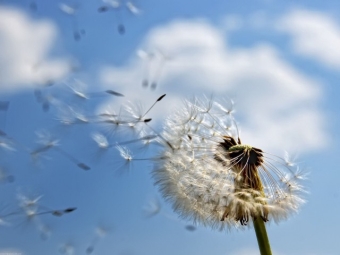
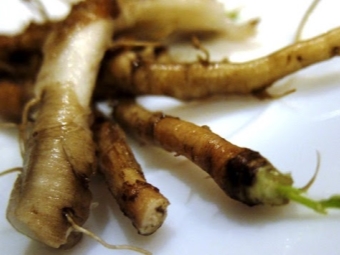
Kinds
The dandelion has larger species, of which there are about 75, and there are smaller ones - there are more than 1000 of them. Of the large species, the most common are:
- dandelion ordinary (medicinal);
- dandelion autumn;
- Bessarabian dandelion.
Some species were listed in the Red Book.
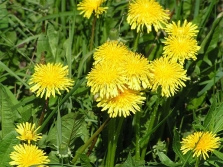


Where does it grow?
The dandelion can be found all over the globe, although it prefers temperate climates the most. One of the typical representatives - common dandelion - is common in the forest-steppe zone. It grows everywhere - in meadows, along roads, on the edges, as a weed in a garden, in a garden or park. Especially often it can be found in Central Russia, in the countries of the Near Abroad, in the Siberian and Far Eastern territories, on the Kamchatka Peninsula, on the Sakhalin Peninsula, in Asian countries, etc. The exception is deserts.

Peculiarities
Young dandelion leaves are slightly bitter in taste, older leaves taste even more bitter, but the flowers, on the contrary, are quite sweet and honey.

Some individual species of dandelion are considered suitable for the extraction of rubber, as they contain it in large quantities.

Characteristics
Dandelion has the following characteristics:
- used in the preparation of various dishes;
- contains many vitamins and minerals;
- it is used not as a seasoning, but as an independent product;
- is a large honey plant.
Dandelion honey has a pleasant color ranging from golden to coppery amber. It is quite thick, has a pronounced smell, but tastes bitter and may seem unpleasant. Also, it tends to dry out quickly.

Nutritional value and calories
100 grams of young and fresh dandelion leaves contain 45 kcal.
The nutritional value of 100 grams of fresh product includes the following components:
- proteins - 2.7 g;
- fats - 0.7 g;
- carbohydrates - 5.7 g;
- dietary fiber - 3.5 g;
- ash - 1.8 g;
- water - 85.6 g;
- mono- and disaccharides - 0.71 g;
- saturated fatty acids - 0.17 g.
You can learn more useful information about dandelion from an excerpt from the program "Live great!"
Chemical composition
The chemical composition of dandelion contains the following components:
- vitamins: β-carotene - 5.854 mg, A (RE) - 508 mcg, B1 (thiamine) - 0.19 mg, B2 (riboflavin) - 0.26 mg, B3 (pantothenic) - 0.084 mg, B6 (pyridoxine) - 0.251 mg , B9 (folic) - 27 mcg, C - 35 mg, E (TE) - 3.44 mg, K (phylloquinone) - 778.4 mcg, PP (niacin equivalent) - 0.806 mg; choline - 35.3 mg;
- macronutrients: calcium - 187 mg, magnesium - 36 mg, sodium - 76 mg, potassium - 397 mg, phosphorus - 66 mg,
- trace elements: iron - 3.1 mg, zinc - 0.41 mg, copper - 171 mcg, manganese - 0.342 mg, selenium - 0.5 mcg.
Dandelion juice contains a few percent rubber substances, the roots contain triterpene compounds, sterols, carbohydrates, and fatty oil. Flowers and leaves are rich in lutein.

Beneficial features
Dandelion has the following beneficial properties:
- contains a huge amount of minerals valuable for the human body;
- relieves swelling;
- helps relieve redness and itching after insect bites;
- used for weight loss
- enhances lactation;
- actively fights toxins;
- improves metabolism;
- helps to whiten the skin.
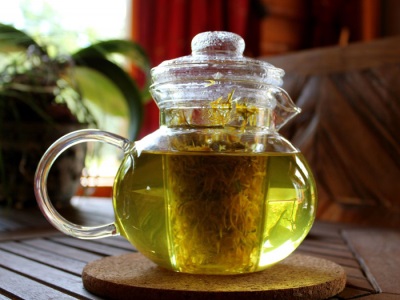
Harm
In some cases, dandelion can contribute to:
- blockage of the bile ducts;
- exacerbation of ulcers or gastritis;
- diarrhea
- vomiting.
Contraindications
It is not recommended to eat or use dandelion as a medicine in the following cases:
- in the presence of problems with the biliary tract;
- in the presence of diseases of the stomach in an acute form;
- if you are allergic to pollen.
The dosage should also be monitored.

Oil
Dandelion oil is obtained by mixing crushed dandelion root with vegetable or olive oil. For 100 g of roots there should be 25 g of oil. You need to insist it for a couple of weeks in a warm room. Dandelion oil is used as an ointment or compress against burns, as well as in the presence of bites, eczema and other inflammations on the skin.
Dandelion oil is also suitable for dressing salads.
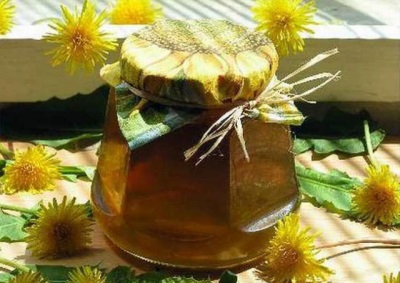
Juice
The juice of the plant strengthens and tones the body. It helps restore the acid-base balance in it. Get it from all parts of the dandelion. To do this, they are crushed and slightly diluted with water. However, before that, for half an hour, dandelions are soaked in cool water, which is pre-salted so that it does not taste so bitter. Juice can be preserved in alcohol.
When combined with carrot and turnip leaf juices, dandelion juice helps strengthen bones, spine, and teeth.
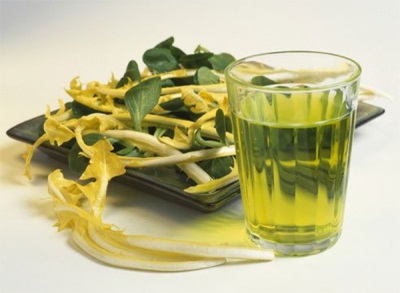
Application
In cooking
The culinary use of dandelion turned out to be quite extensive:
- used in the preparation of various purees;
- leaves are added to green cabbage soup, soups (including borscht) or salads;
- sometimes added to vinaigrettes;
- jam is made from flowers;
- dandelion wine is made from buds, flowers and stems;
- leaves can be pickled or fermented;
- boiled leaves sometimes replace spinach.
Sometimes young leaves are steamed and baked in dough. Flowers are often used to decorate various dishes, and teas, jellies and syrups are also made from them. There are several options for a delicious and healthy salad with the addition of dandelion leaves.

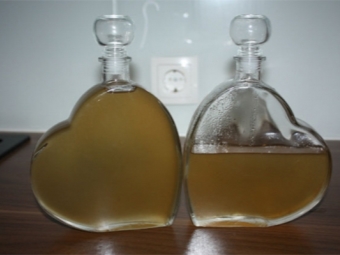
Dandelion salad
First recipe:
- young leaves are finely cut and salted;
- add finely chopped onions and carrots;
- if desired, the salad can be seasoned with sour cream or olive oil with the addition of lemon juice.
Second recipe:
- 100 g of fresh dandelion leaves are washed well, and then soaked for half an hour in cool water, which must first be salted;
- greens are dried and cut;
- wash, dry and cut a few feathers of green onions and parsley (there should be an equal amount);
- the greens are mixed, salted, peppered, sprinkled with a tablespoon of balsamic vinegar and seasoned with a few tablespoons of olive oil;
- dill sprigs are used as a salad decoration.


Dandelion flower jam
Dandelion jam is especially popular, which can be prepared according to the following recipe:
- 400 flowers, a lemon, a liter of water and a kilogram of sugar are needed;
- inflorescences are collected in the opened form, preferably on a sunny fine day;
- they are washed and soaked for 24 hours, then the water is drained and the flowers are washed again;
- pour the flowers with a liter of water, cut the lemon with the peel, boil with the inflorescences and leave for 2 hours;
- filter the workpiece, and a kilogram of sugar is poured into the resulting syrup;
- cook the workpiece (cooking time depends on the desired degree of density);
- the optimal cooking time is 45 minutes, but the longer the jam is on fire, the thicker it will turn out;
- when rolling jam into jars for the winter, you can add more sugar.

In medicine
For medicine, dandelion is a valuable plant. Use it like this:
- as a choleretic and diuretic;
- as an anti-inflammatory agent;
- for blood purification;
- to improve appetite;
- with violations of the digestive tract;
- with liver diseases;
- for the treatment of intestinal diseases;
- for the treatment of hemorrhoids;
- for the treatment of diseases of the joints;
- to normalize the work of the heart and blood vessels;
- with diabetes;
- for wound healing;
- for the treatment of inflammation on the skin;
- to tone the body;
- to reduce pressure;
- to combat warts and papillomas, etc.

Traditional medicine recipes
- Decoction. To prepare a decoction of dandelions, a few tablespoons of crushed roots are poured with a liter of boiling water. The broth is boiled for 25 minutes under the lid, then cooled and filtered. Drink warm three times a day for half a cup an hour before meals. This will help improve appetite and activate the pancreas.
- Infusion to increase appetite. RIt is recommended to insist two teaspoons of crushed roots in 200 ml of cool water for 7-9 hours and drink 50 ml before meals.
- Infusion. With a weakened immune system, a spoonful of crushed leaves and roots is poured with 200 ml of boiling water and insisted in a thermos for a couple of hours. Then the broth is filtered and taken 50 ml several times a day before meals.
- Juice and porridge.Also, dandelion juice can reduce warts. Young leaves are recommended to be crushed and applied to areas on the skin that are inflamed from insect bites. Also, the leaves, crushed into gruel, effectively help to heal wounds and ulcers.


In cosmetology
Alcohol infusion on dandelion flowers can effectively fight acne and papillomas. Masks with the addition of fresh young leaves of the plant effectively nourish the skin, moisturizing and making it more elastic and supple. Infusions of flowers help whiten the skin and make freckles much paler.

When losing weight
Most often, when losing weight, dandelion roots are used, which help improve metabolic processes in the body.It is used in the form of decoctions and infusions. They remove excess fluid from the body, and also relieve swelling.
Due to the low calorie content of the plant, you can safely use vegetable salads with the addition of dandelion leaves. They contain a large amount of vitamins that will be useful for the body.

At home
Household uses of dandelion are as follows:
- used in official and informal medicine;
- present in dishes of different cuisines of the world;
- used as an extract in various cosmetics;
- is part of the herbal diet for weight loss.

cultivation
Dandelion can be grown in a greenhouse, vegetable garden, or even at home. The plant does not require special care for itself; it is not for nothing that it has become a weed hated by many gardeners. Light shade or sun is suitable as lighting.
Soil moisture usually does not matter much. Dandelion will grow best in cool, moist soils. When planting plants with seeds, it is necessary that the distance between them is at least 0.1 m.
The frequency of watering should be chosen so that the soil has time to dry out. Constant humidity does not affect the growth of the plant too well.

Interesting Facts
- Dandelion roots are sometimes roasted and ground to make a kind of coffee substitute.
- Dandelions are fed to many rodents. For example, rabbits.
- Dandelion is considered a weed, the fight against which is quite difficult. The plant regenerates amazingly quickly, but this ability is manifested after its first seeds appear. During the flowering period, it is just recommended to rid the land of areas clogged with plants.


















Dandelion is truly amazing! Next year I will try to make jam.